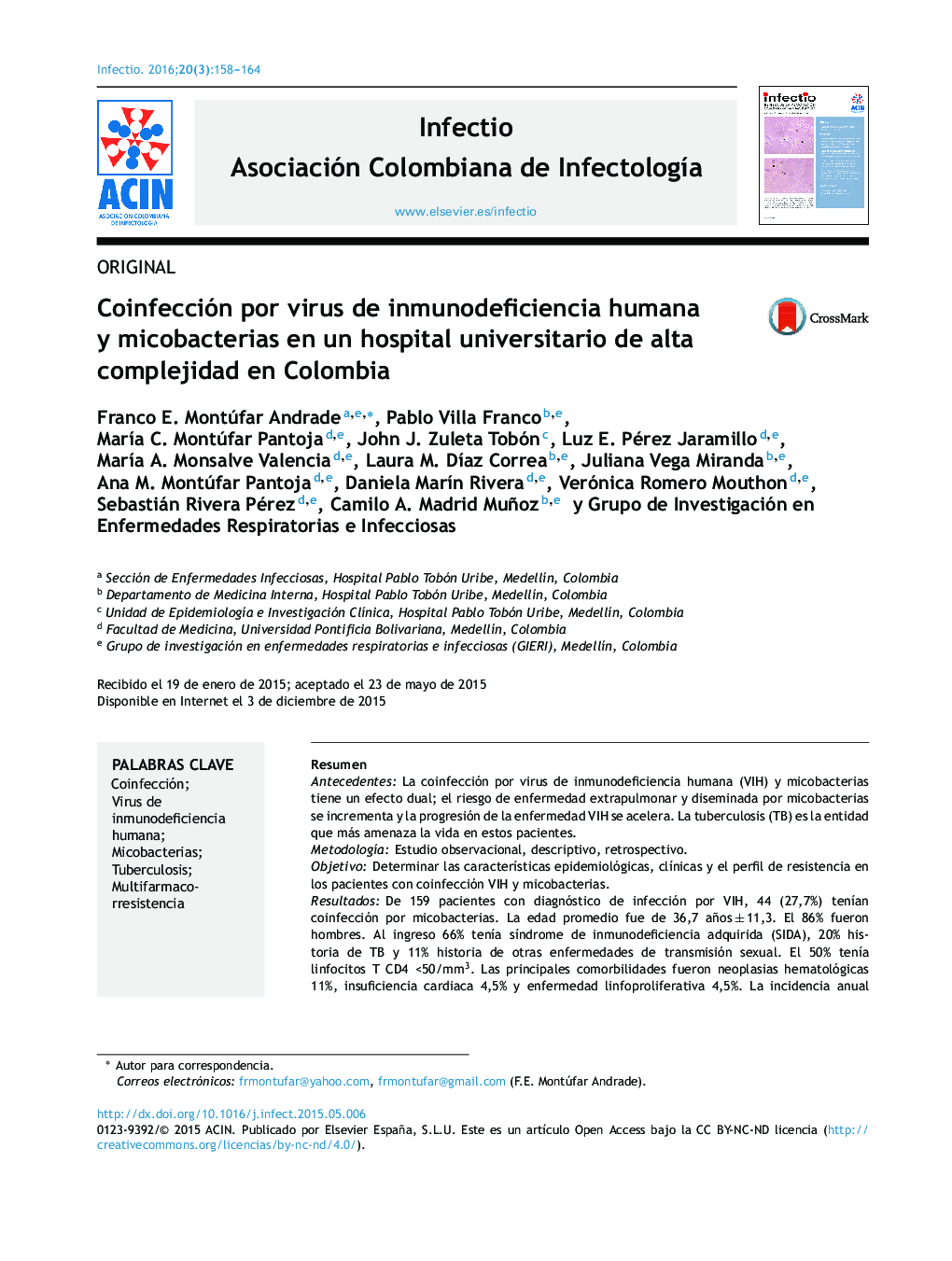| Article ID | Journal | Published Year | Pages | File Type |
|---|---|---|---|---|
| 3403622 | Infectio | 2016 | 7 Pages |
ResumenAntecedentesLa coinfección por virus de inmunodeficiencia humana (VIH) y micobacterias tiene un efecto dual; el riesgo de enfermedad extrapulmonar y diseminada por micobacterias se incrementa y la progresión de la enfermedad VIH se acelera. La tuberculosis (TB) es la entidad que más amenaza la vida en estos pacientes.MetodologíaEstudio observacional, descriptivo, retrospectivo.ObjetivoDeterminar las características epidemiológicas, clínicas y el perfil de resistencia en los pacientes con coinfección VIH y micobacterias.ResultadosDe 159 pacientes con diagnóstico de infección por VIH, 44 (27,7%) tenían coinfección por micobacterias. La edad promedio fue de 36,7 años ± 11,3. El 86% fueron hombres. Al ingreso 66% tenía síndrome de inmunodeficiencia adquirida (SIDA), 20% historia de TB y 11% historia de otras enfermedades de transmisión sexual. El 50% tenía linfocitos T CD4 <50/mm3. Las principales comorbilidades fueron neoplasias hematológicas 11%, insuficiencia cardiaca 4,5% y enfermedad linfoproliferativa 4,5%. La incidencia anual fue de 4,6%. Las formas diseminadas fueron el 54% de los casos. Se identificó M. tuberculosis en 77,3%, micobacterias no tuberculosas (MNT) en 18,3% y en el 4,5% no fue posible establecer la especie. El 2,5% de los aislamientos de M. tuberculosis fueron multifarmacorresistentes (TB-MDR) y en 18,2% se identificó resistencia a un solo fármaco o resistencia combinada. En el 54% de los pacientes se documentó compromiso pulmonar. La letalidad fue del 9,1%.ConclusiónEn nuestros pacientes, la infección por M. tuberculosis es la más frecuente y es llamativa la alta prevalencia de resistencia al menos a un fármaco y la TB-MDR. Las infecciones por MNT son cada vez más frecuentes. Las formas diseminadas y extrapulmonares son muy importantes. La incidencia anual es alta.
BackgroundCo-infection with the human inmunodeficiency virus (HIV) and mycobacteria has a synergistic effect; the risk of extrapulmonary and disseminated mycobacterium disease is increased and the progression of HIV disease is accelerated. Tuberculosis (TB) is the entity that is most life threatening to these patients.MethodologyObservational, descriptive and retrospective study.ObjectiveTo determine the epidemiological and clinical characteristics and the resistance profile in patients coinfected with HIV and mycobacteria.ResultsOf 159 patients diagnosed with HIV, 44 (27.7%) patients were co-infected with mycobacteria. The average age was 36.7 years ± 11.3. Some 86% were men. At admission, 66% had acquired immune deficiency syndrome (AIDS), 20% a history of TB and 11% a history of other sexually transmitted diseases. A total of 50% reported a count of CD4 lymphocytes less than 50 cells/mm3. Major comorbidities were haematological malignancies in 11%, heart failure in 4.5%, and lymphoproliferative disease in 4.5%. The annual incidence was 4.6%. Disseminated forms were found in 54% of cases. M. tuberculosis was identified in 77.3%, non-tuberculous mycobacteria (NTM) in 18.3% and in 4.5%, it was not possible to establish the species. Some 2.5% of isolates of M. tuberculosis were multidrug-resistant (MDR-TB) and 18.2% were resistant to a single drug or had combined resistance. There was documented pulmonary involvement In 54% of patients. Mortality was 9.1%.ConclusionIn our patients, infection with M. tuberculosis was the most common and the high prevalence of resistance to at least one drug and MDR-TB was striking. NTM infections are becoming more common. The extra-pulmonary and disseminated forms are common, and annual incidence is high.
